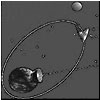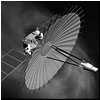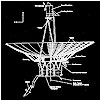|
|
Crowned with a 10-meter antenna, the Spektr-R radio telescope undergoes final tests. |
|
|||||||
|
|
||||||||
|
With its roots in the 1980s, Spektr-R (a.k.a. Radioastron) became the first Russian astrophysics spacecraft to go into orbit in the 21st century. It promised to open door to a whole new generation of space observatories and to jump-start space-based astronomy in the nation. |
|||||||||
|
In 2002, the Russian Academy of Sciences gave Spektr-R the highest priority among the nation's astrophysics missions. Its launch was then planned no later than 2007, to beat similar US and Japanese missions, which were anticipated in 2008. However, Spektr-R was not able to reach the launch pad until 2011. |
||||||||
 |
The primary goal of the Spektr-R mission was to study structure and dynamics of radio sources inside and outside of our Milky Way galaxy. This research could help in understanding of fundamental mysteries of astrophysics, including black holes and dark matter. Working in conjunction with ground-based antennas, Spektr-R would form a gigantic virtual telescope with an unprecedented resolution. |
||||||||
|
Triumphing over three decades of historic cataclysms, economic problems and social cynicism, Russian astrophysical science re-invaded the outer space with its first 21st-century orbital observatory. The historic importance of the Spektr-R mission, which successfully reached orbit Monday morning, is difficult to overestimate. |
|||||||||
 |
2017: Spektr-R makes critical orbit correction By January 2017, more than 100 requests from different countries for observation time on the Spektr-R orbital radio telescope had been received for the 5th round of the so-called open scientific program which was to begin on July 1, 2017. In the meantime, the spacecraft needs a crucial orbit correction. |
||||||||
 |
2019: Spektr-R stops observations (INSIDER CONTENT) Potentially ending an era in the Russian space science, Spektr-R-experienced a major communications failure on Jan. 10, 2019, interrupting scientific research with a unique instrument. Russian ground controllers were not giving up hope for the revival of the 7.5-year-old spacecraft. |
||||||||
TECHNOLOGY |
|||||||||
 |
The heart of the telescope would be a 10-meter antenna, sporting 27 carbon fiber petals. Petals surrounded a solid focal dish with a diameter of three meters. When open, the mirror of the telescope would have to retain its position within just two millimeters of the pre-determined curve. The spacecraft was designed to be launched by the Zenit rocket with the Fregat upper stage. |
||||||||
|
Like all other space observatories in the Spektr series, the Spektr-R mission was built around the standard Navigator platform, which served as a service module for the spacecraft. It provided navigation, power-supply and flight control functions for the Spektr-R mission. |
|||||||||
|
|
||||||||